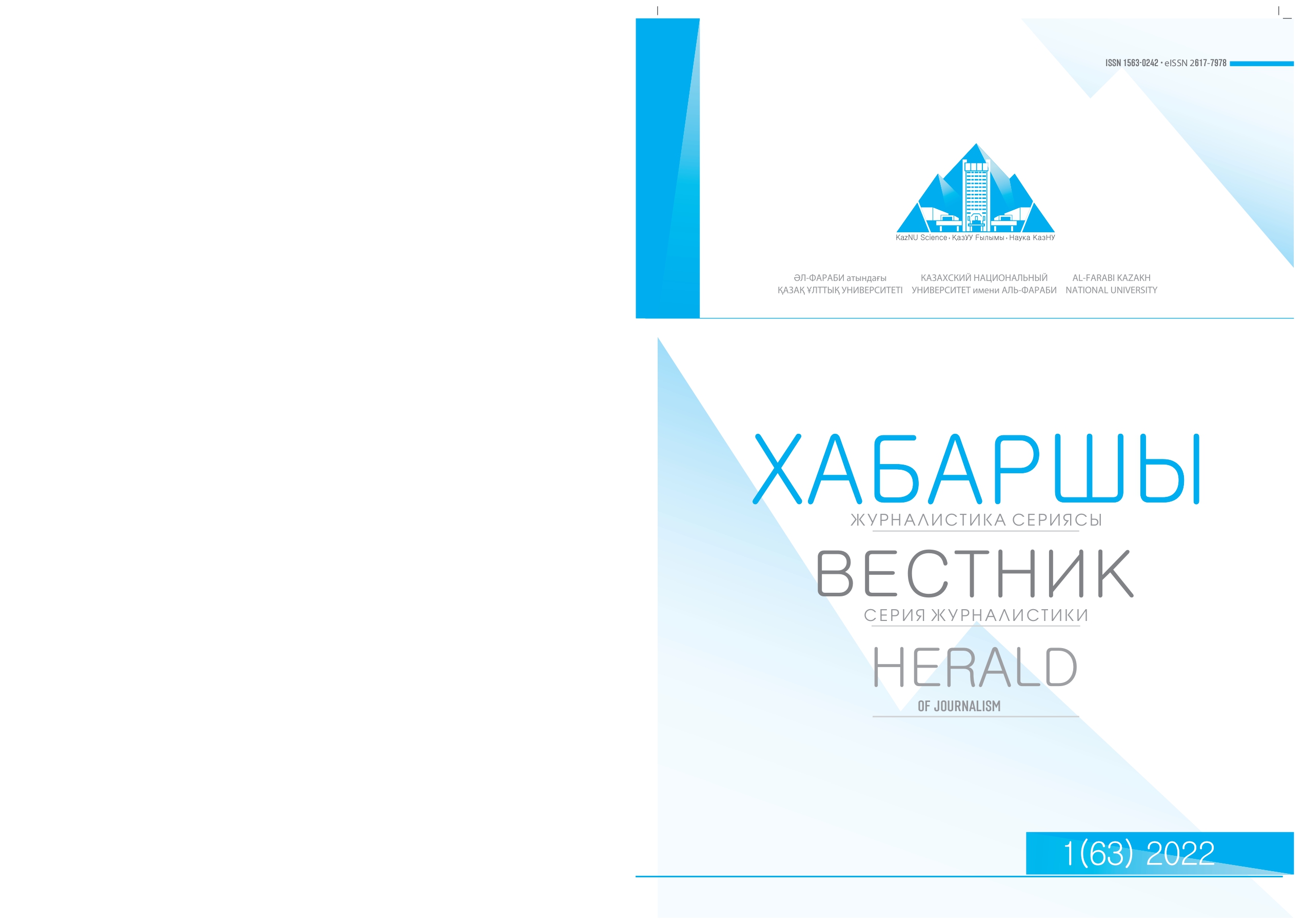Сөз бостандығы контекстінде журналистикадағы цензура және автоцензура зерттеулеріне сипаттама
DOI:
https://doi.org/10.26577/HJ.2022.v63.i1.12Аннотация
Демократиялық мемлекетті дамыту үшін қоғамның сөз бостандығы жайлы түсінігі өте маңызды (Çarkoğlu & Andı, 2020). Бейтарап, объективті және шынайы ақпарат беруі тиіс журналистика, әрдайым, барлық қоғамда өз міндетін толықтай атқара алмайды. Бұл сол ел мен қоғамдағы түрлі факторға тәуелді. Аталмыш мәселені түсіну үшін журналистика мектебінің білім алушылары медиадағы сөз бостандығына қатысты терминдерді меңгеруі қажет.
Ғылыми зерттеудің негізгі мақсаты – медиа және коммуникация саласында осыған дейін цензура және автоцензураға қатысты қандай зерттеулер жасалғанын және олардың негізгі идеясы қандай болғанын анықтау. Сондай-ақ, олардың қазіргі сәттегі өзектілігі мен ақпаратты өндіру процесіндегі маңыздылығы қандай деген сұрақтардың жауабын іздейді. Бұл терминдер осыған дейін посткеңестік елдерге қарағанда батыс әлемінде көп зерттелгендіктен, жұмыста Пол О'Хиггинс, Шамик Сэн және Кук пен Хэйлман сияқты зерттеушілердің жұмысына басымдық беріледі. Сөз бостандығына қатысты отандық материалдар да қарастырылады.
Жұмыстың ғылыми-практикалық маңыздылығы – цензура мен автоцензураның медианың күн тәртібін қалыптастыруда және журналистік қызметті жүзеге асыруда қандай әсері бар екенін түсініп, оны мүмкіндігінше азайту немесе дұрыс қолдану үшін болашақ маманның студент кезінен осы терминдерді ажырата білуінде.
Зерттеудің нәтижесі бойынша, көптеген зерттеушілер цензура – мемлекеттің тарапынан болатын қысым десе, ал автоцензура – журналистің осы қысымға жауабы деп айтады. Ольга Зевелеваның айтуынша, цензура автоцензура жұмыс істемеген сәтте активті болады (Зевелева, 2020), яғни цензура – бұл тиімді жұмыстың нәтижесі ретінде сипатталады. Кейінгі жылдары жазылған батыс әдебиетіндегі зерттеулердің шолу нұсқасымен таныса отыра, болашақ мамандар бұл білімін әрі қарай тақырыпты ғылыми зерттеуге, медиа теорияларын түсінуге және журналистік қызметін атқаруда қолдана алады.
Кілт сөздер: цензура, автоцензура, сөз бостандығы, күн тәртібі.
Библиографиялық сілтемелер
Abramov, D.(2010). Results of research “Kazakhstan mass media: key participants, possibilities, needs and risks”. The International Centre of Journalism MediaNet
Bodrunova, S. S., Litvinenko, A., & Nigmatullina, K. (2021). Who is the censor? Self-censorship of Russian journalists in professional routines and social networking. Journalism, 22(12), 2919–2937. https://doi.org/10.1177/1464884920941965
Çarkoğlu, A., & Andı, S. Support for Censorship of Online and Offline Media: The Partisan Divide in Turkey. The International Journal of Press/Politics, 194016122093532. https://doi.org/10.1177/1940161220935322
Çipuri, R. (2015). Reasons of self-censorship landscape for journalists. International research review, Thesis no 1.
Cook, P., & Heilmann, C. (2013). Two Types of Self-Censorship: Public and Private. Political Studies, 61(1), 178–196. https://doi.org/10.1111/j.1467-9248.2012.00957.x
Elbaz, Sagi & Magal, Tamir & Nets-Zehngut, Rafi & abutbul selinger, Guy. (2017). Self-Censorship of Narratives of Political Violence in the Media. 10.1007/978-3-319-63378-7_6.
Fedirko, T. (2020). Self-censorships in Ukraine: Distinguishing between the silences of television journalism. European Journal of Communication, 35(1), 12–28. https://doi.org/10.1177/0267323119897424
Freedman, E., & GRAHAM, N. A. (2011). Theoretical Foundations for Researching the Roles of the Press in Today’s Central Asia. In E. Freedman & R. Shafer (Eds.), After the Czars and Commissars: Journalism in Authoritarian Post-Soviet Central Asia (pp. 1–16). Michigan State University Press. http://www.jstor.org/stable/10.14321/j.ctt7ztd46.3
Jungblut, M., & Hoxha, A. (2017). Conceptualizing journalistic self-censorship in post-conflict societies: A qualitative perspective on the journalistic perception of news production in Serbia, Kosovo and Macedonia. Media, War & Conflict, 10(2), 222–238. https://doi.org/10.1177/1750635216673283
Internews(2019). Issledovaniye potrebitel'skoy mediasoobshchestva Kazakhstana, 46
Kenny, T., & Gross, P. (2008). Journalism in Central Asia: A Victim of Politics, Economics, and Widespread Self-censorship. The International Journal of Press/Politics, 13(4), 515–525. https://doi.org/10.1177/1940161208324644
Koshkenov, N.,& Utemissov, Z.(2021). Kazakhstan media challenges in the context of media and government relations in the Republic of Kazakhstan. Bulletin of L.N. Gumilyov Eurasian National University. Journalism Series, № 1(134). 10.32523/2616-7174-2021-134-1-37-51
Milton, J(1644). AREOPAGITICA (JEBB ED.) http://files.libertyfund.org/files/103/1224_Bk.pdf
Myssayeva, K. (2021). Journalism education during the Independence years of Kazakhstan. Herald Of Journalism, 62(4), 4-12. doi:10.26577/HJ.2021.v62.i4.01
Newth, M.(2010). The long history of censorship http://www.beaconforfreedom.org/liste.html?tid=415&art_id=475
Oxford Reference. (n.d.). Censorship. In Oxfordreference.com. https://www.oxfordreference.com/view/10.1093/oi/authority.20110803095558166
Sak, K., & Ryskeldinova, S. B.(2021). Freedom of speech as a key condition for democracy. Bulletin of L.N. Gumilyov Eurasian National University. Journalism Series, № 1(134). 10.32523/2616-7174-2021-134-1-27-36
Scheufle, D.A., & Moy, P. (2000). TWENTY-FIVE YEARS OF THE SPIRAL OF SILENCE: A CONCEPTUAL REVIEW AND EMPIRICAL OUTLOOK. International Journal of Public Opinion Research, 12, 3-28.
Schimpfossl, E., & Yablokov, I. (2014). Coercion or Conformism? Censorship and Self-Censorship among Russian Media Personalities and Reporters in the 2010s. Demokratizatsiya: The Journal of Post-Soviet Democratization, 22(2), 295-311.
Schultz, D. On Liberty. https://www.mtsu.edu/first-amendment/article/872/on-liberty
Sen, S. (2014). RIGHT TO FREE SPEECH AND CENSORSHIP: A JURISPRUDENTIAL ANALYSIS. Journal of the Indian Law Institute, 56(2), 175–201. http://www.jstor.org/stable/43953700
Shafer, R., & GRAHAM, N. A. (2011). Soviet Foundations of the Post-Independence Press in Central Asia. In R. Shafer & E. Freedman (Eds.), After the Czars and Commissars: Journalism in Authoritarian Post-Soviet Central Asia (pp. 19–32). Michigan State University Press. http://www.jstor.org/stable/10.14321/j.ctt7ztd46.4
Sun, T., & Zhao, Q. (2021). Delegated Censorship: The Dynamic, Layered, and Multistage Information Control Regime in China. Politics & Society. https://doi.org/10.1177/00323292211013181
Tai, Q. (2014). China’s Media Censorship: A Dynamic and Diversified Regime. Journal of East Asian Studies, 14(2), 185–209. http://www.jstor.org/stable/26335242
Yesil, M. & Mahallesi, Karaciğan & Caddesi, Ankara & Karatay, & Turkey, Konya. (2014). The Invisible Threat for the Future of Journalism: Self-Censorship and Conflicting Interests in an Increasingly Competitive Media Environment. 3.
Zeveleva Olga (2020). Self-censorship of journalists in Tatarstan and Crimea in a comparative perspective: Pierre Bourdieu and the new theory of censorship. Laboratory: Journal of Social Research. 12(3):150–177 DOI: 10.25285/2078-1938-2020-12-3-150-177
Электронды ресурстар
https://freedomhouse.org/country/kazakhstan/freedom-world/2020
https://www.azattyq.org/a/31187155.html
https://web.telegram.org/z/#-1203983871
https://vlast.kz/obsshestvo/31155-cto-ne-tak-s-goszakazom-v-smi.html
https://qamshy.kz/article/65098-manhghystau-oblysyna-9-vagon-arpa-dgetkizildi#




